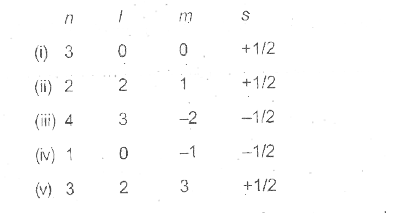Which set of quantum numbers is not possible ?
nlm s320+1/2
nlm s221+1/2
nlm s100−1/2
nlm s32−2+1/2
The correct Answer is:B
To determine which set of quantum numbers is not possible, we need to understand the rules governing the quantum numbers:
1. Principal Quantum Number (n): This can take positive integer values (1, 2, 3, ...).
2. Azimuthal Quantum Number (l): This can take values from 0 to (n-1).
3. Magnetic Quantum Number (ml): This can take values from -l to +l, including zero.
4. Spin Quantum Number (ms): This can be either +1/2 or -1/2.
Now, let's analyze each option step by step:
Step 1: Analyze Option 1
- Given: n = 3, l = 2, ml = 0
- Here, l can take values from 0 to (n-1) = 2.
- Since l = 2 is valid, we check ml:
- ml can range from -l to +l, which means ml can be -2, -1, 0, 1, or 2.
- This option is valid.
Step 2: Analyze Option 2
- Given: n = 2, l = 2
- Here, l must be less than n, so l can only be 0 or 1 (0 to n-1).
- Since l = 2 is not valid, this option is not possible.
Step 3: Analyze Option 3
- Given: n = 1, l = 0, ml = 0
- Here, l can take values from 0 to (n-1) = 0.
- Since l = 0 is valid, we check ml:
- ml can only be 0 when l = 0.
- This option is valid.
Step 4: Analyze Option 4
- Given: n = 3, l = 2, ml = -2
- Here, l can take values from 0 to (n-1) = 2.
- Since l = 2 is valid, we check ml:
- ml can range from -2 to +2, which includes -2.
- This option is valid.
Conclusion
The only invalid set of quantum numbers is from Option 2: (n=2, l=2).
2. Azimuthal Quantum Number (l): This can take values from 0 to (n-1).
3. Magnetic Quantum Number (ml): This can take values from -l to +l, including zero.
4. Spin Quantum Number (ms): This can be either +1/2 or -1/2.
- Given: n = 3, l = 2, ml = 0
- Here, l can take values from 0 to (n-1) = 2.
- Since l = 2 is valid, we check ml:
- ml can range from -l to +l, which means ml can be -2, -1, 0, 1, or 2.
- This option is valid.
- Given: n = 2, l = 2
- Here, l must be less than n, so l can only be 0 or 1 (0 to n-1).
- Since l = 2 is not valid, this option is not possible.
- Given: n = 1, l = 0, ml = 0
- Here, l can take values from 0 to (n-1) = 0.
- Since l = 0 is valid, we check ml:
- ml can only be 0 when l = 0.
- This option is valid.
- Given: n = 3, l = 2, ml = -2
- Here, l can take values from 0 to (n-1) = 2.
- Since l = 2 is valid, we check ml:
- ml can range from -2 to +2, which includes -2.
- This option is valid.
The only invalid set of quantum numbers is from Option 2: (n=2, l=2).
Topper's Solved these Questions
- STRUCTURE OF ATOMBook:PRADEEPChapter:STRUCTURE OF ATOMExercise:Competition Focus (JEE (Main and Advanced)/Medical Entrance (II. Multiple Choice Question)
Explore 9 Videos
- STRUCTURE OF ATOMBook:PRADEEPChapter:STRUCTURE OF ATOMExercise:Competition Focus (JEE (Main and Advanced)/Medical Entrance (III. Multiple Choice Question) (Based on Comprehension)
Explore 20 Videos
- STRUCTURE OF ATOMBook:PRADEEPChapter:STRUCTURE OF ATOMExercise:Analytical Questions And Problems with Answers/solutions (Problems)
Explore 18 Videos
- STATES OF MATTER: SOLID MATTERBook:PRADEEPChapter:STATES OF MATTER: SOLID MATTERExercise:COMPETITION FOCUS (ASSERTION-REASON)
Explore 17 Videos
- THERMODYNAMICSBook:PRADEEPChapter:THERMODYNAMICSExercise:MULTIPLE CHOICE QUESTION ( BASED ON PRACTICAL CHEMISTRY)
Explore 3 Videos
Similar Questions
Knowledge Check
which set of quantum number si not possible ?
An=1,l=1,m1=+1,ms=−12Bn=3,l=2,m1=+1,ms=+12Cn=4,l=4,m1=−1,ms=+12Dn=5,l=2,m1=2,ms=−12Which set of quantum number is not possible for electron un 3rd shell ?
An=3l=2m=−1s=+1/2Bn=3l=2m=−1s=−1/2Cn=3l=2m=0s=+1/2Dn=3l=3m=0s=−1/2Which of the following set of quantum numbers is not possible ?
An=3,l=0,m=0Bn=3,l=1,m=−1Cn=2,l=0,m=−1Dn=2,l=1,m=0
Consider the following sets of quantum number

Which of the following sets of quantum number is not possible ?
View SolutionWhich one of the following sets of quantum numbers is not possible?
View SolutionWhich set of quantum numbers is possible for the last electron of Mg+ ion
View SolutionConsider the following sets of quantum number

Which of the following sets of quantum number is not possible?
View SolutionConsider the following sets of quantum number

Which of the following sets of quantum number is not possible?
View Solution

